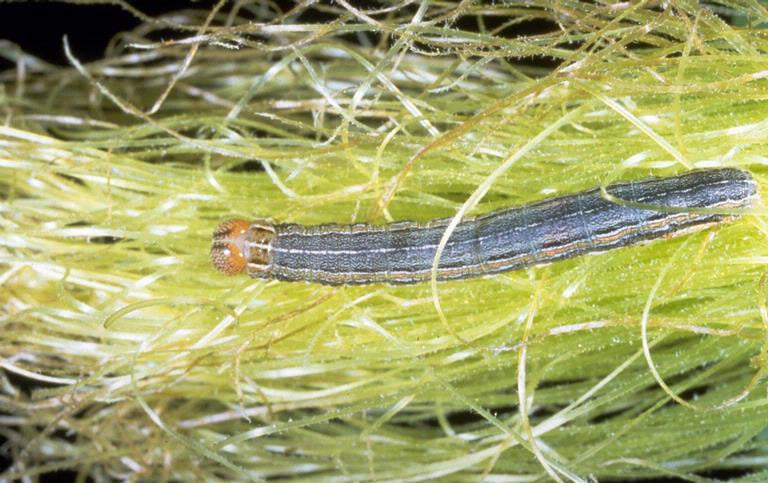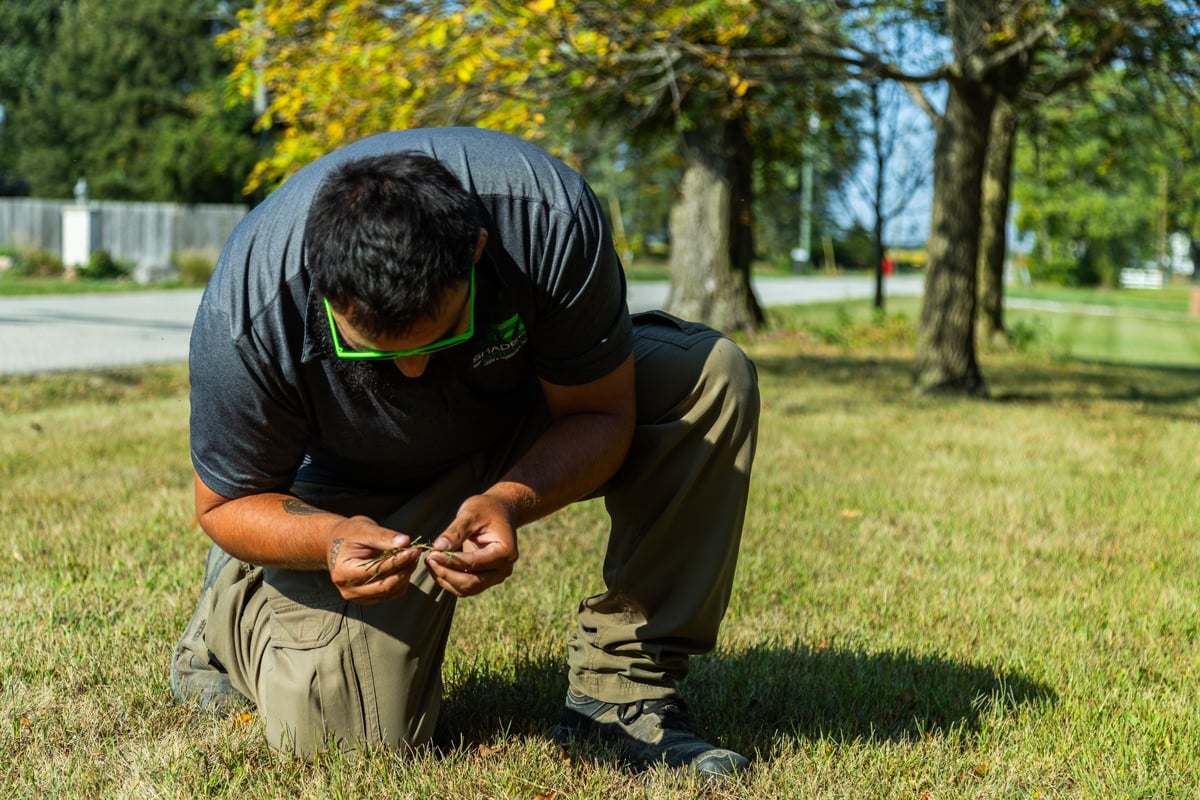



There are few things more frustrating than looking out the window, expecting to see a lush, green lawn, only to be greeted by bare patches, weeds throwing a party, or grass that’s more brown than your morning coffee. If you’ve been shaking your head and wondering, “What’s wrong with my lawn?”, you are not alone.
Unfortunately, the answer to your question is not as simple as it might seem. Your lawn could be battling a whole lot – from disease to pests to weeds, or even just bad maintenance practices.
So, if you feel like you are regularly asking yourself, “What’s killing my grass?”, you are not paranoid. Something probably is. But before you light your lawn on fire and start over, know that you are in the right place. Let’s walk through some of the most common lawn problems and solutions so you can get the scoop on diagnosing lawn damage like a pro and stop asking “What’s causing dead grass patches?” every time you walk to the mailbox.
Table of Contents:
What’s Wrong with My Lawn?
The Most Common Lawn Problems and How to Fix Them
How to Get Rid of Lawn Weeds
Lawn Disease Symptoms and Solutions
How to Identify and Treat Insect Damage in Grass
Other Indiana Lawn Problems
Diagnosing Lawn Problems and DIY Solutions
Best Lawn Repair Tips
FAQ: Lawn Problems in Indiana
Indiana lawns can be a bit dramatic. The truth is, a struggling lawn can be caused by a whole bunch of different things. Maybe it’s pests throwing a party underground. Maybe your grass is hungry. Maybe it’s just really not a fan of your watering schedule. Diagnosing lawn damage isn’t always straightforward - it’s kind of like trying to figure out why your toddler is crying…again.
Common lawn issues like thinning grass, weed invasions, or odd color changes can all stem from:
 If your lawn is looking more “meh” than magnificent, you are probably dealing with one (or several) of the classic lawn culprits. We’re talking weeds, diseases, insect damage, weird color changes, and annoying bare spots.
If your lawn is looking more “meh” than magnificent, you are probably dealing with one (or several) of the classic lawn culprits. We’re talking weeds, diseases, insect damage, weird color changes, and annoying bare spots.
The thing is, there’s no one-size-fits-all answer to lawn issues. What looks like simple yellowing could be a sign of lawn stress from heat, poor watering habits, a soil issue, treatments happening at the wrong time, or even sneaky grubs. Diagnosing lawn damage takes a little know-how and a lot of close-up lawn detective work.
In the next sections, we’ll break down the big hitters of lawn problems and solutions.
If you’ve ever wondered why weeds in your lawn keep popping up like that one fly that refuses to leave your kitchen, the truth is, weeds are sneaky opportunists. They thrive when your grass is stressed, patchy, or just plain tired of fighting. Whether it is from compacted soil, lack of nutrients, or a few bare spots giving them a foothold, they know how to make themselves at home. And once they settle in? Let’s just say they are there for the long haul.
Crabgrass is the ultimate opportunist. It has wide, light-green blades and sprawls out low to the ground. It shows up in bare, sunny spots, especially where the lawn is thin or stressed. This summer annual loves compacted soil and hot, dry conditions. Once it germinates in spring, it grows fast and produces thousands of seeds. Miss it for one year, and you’ll see even more the next.
The best way to stop crabgrass is to prevent it before it starts. Use a pre-emergent herbicide in early spring and focus on keeping your lawn thick and healthy. Mow high, water consistently, and patch bare spots early to block it out.
Dandelions are hard to miss with their bright yellow flowers that turn into fluffy white seed heads. Their jagged leaves grow in a rosette pattern close to the ground, and they pop up just about anywhere – sunny yards, patchy lawns, and even sidewalk cracks. They thrive in compacted or nutrient-poor soils and spread fast thanks to their lightweight seeds. Their deep taproots make them hard to pull completely, so they often come back if not handled right.
To get dandelions under control, focus on thickening up your turf, improving soil health, and spot treating with post-emergent herbicides when needed. A dense lawn leaves less room for them to wiggle in.
Clover forms low, dense patches with three-lobed leaves and little white or pink flowers. It loves compacted, under-fertilized lawns and shows up where grass is struggling, especially in low-nitrogen soils. Clover actually pulls nitrogen from the air and puts it into the soil, which gives it an unfair advantage over your hungry turf. It can quickly take over and make your lawn look patchy and uneven.
If clover is creeping in, it’s a sign that your lawn wants more nutrients. A proper fertilization program, especially one with the right nitrogen balance, can help grass outcompete it over time.
Annual bluegrass, or Poa annua, shows up as lime-green patches in early spring and quickly stands out from your regular turf. It thrives in cool, moist conditions, often germinating in fall or winter, and loves compacted soils, shade, and overwatered areas. While it may blend in at first, it produces thousands of seeds and then dies off in summer heat, leaving unsightly bare spots that invite more weeds. Low mowing, excess nitrogen in the fall, and poor drainage all contribute to its spread.
Prevent Poa annua with a fall pre-emergent herbicide and by maintaining healthy, dense turf. Proper mowing, watering, and fall fertilization practices can make a big difference in keeping this weed out of your lawn.
At first glance, yellow nutsedge might just look like a weird kind of grass, but don’t be fooled. This fast-growing imposter has a thicker, triangle-shaped stem and glossy V-shaped leaves that grow faster and taller than your regular grass. It also has yellowish seed heads and thrives in wet, poorly drained soils. It has tubers spread underground (called nutlets) that store energy and make it really hard to get rid of.
Managing soil drainage and improving lawn density are key to stopping it, and sometimes, herbicides designed specifically for sedges are needed to kick it out for good.
The secret for kicking weeds out isn’t just yanking them up one by one and hoping for the best. The key is understanding what’s causing the lawn issues in the first place and creating an environment where your grass, not weeds, can thrive. Each type of weed has its own quirks and comeback strategies, so diagnosing the culprit accurately is key to keeping your grass happy and weed-free.
Since certain weeds in lawn thrive under specific conditions, here’s what different types of weed growth in Indiana might indicate:
Before reaching for that weed killer, take a step back. The best weed control starts with understanding your lawn and giving your grass the conditions it needs to crowd weeds out on its own. Here’s how to develop a weed control program that works:
Identify the type or types of turfgrass in your lawn. This could be Kentucky bluegrass, perennial rye grass, Turf Type Tall Fescue, etc.
Keep track of which weeds you are seeing and what time of year they appear. Are they summer annuals like crabgrass or perennial spreaders like dandelions? This helps you time treatments effectively.
Was it compacted soil? Too much shade? Mowing too low? Find the underlying cause of the weed invasion so you can fix the environment that let it in.
Not every weed issue needs chemicals. Sometimes, improving cultural practices is enough. But if herbicides are necessary, choose the right product for your weed and turf type, and apply it at the correct time for best results.
Aerate, mow, fertilize, overseed. A dense, healthy lawn is your best defense against weeds – more on this to come.
When your lawn suddenly starts turning brown or thinning out in odd patches, it’s easy to assume it’s a watering issue or a nutrient problem. But sometimes, the real culprit is a lawn disease, and these can be tricky to diagnose and treat.
Lawn fungus issues can sneak in when conditions are just right: warm, humid weather, compacted soils, poor drainage, or even an unbalanced fertilization schedule. Even when you do everything right, diseases can still show up and leave your turf looking patchy and unhealthy. That’s why knowing what you are dealing with, and how to treat it, is key to restoring your lawn's health.
Appearing from spring to fall, Dollar Spot causes small tan patches that can merge into larger areas. Look for silver dollar-sized tan patches and blades with bleached centers and reddish edges. It is usually caused by nitrogen deficiency and warm, humid conditions. For lawn fungus treatment, fertilize regularly, water in the morning, aerate to help improve airflow, and use fungicides if it is spreading aggressively.
This common spring and fall lawn disease gives grass a pinkish tint and thrives in underfed turf. Look for pink or red patches with thread-like strands and thinning grass. It is usually caused by low nitrogen and cool, wet weather. To treat it, try applying nitrogen-rich fertilizer, mowing with sharp blades, watering in the morning, and using lawn fungicide only if the disease is severe.
A fast-spreading summer disease that creates large, circular brown patches. Look for 4-12 inch brown patches, gray “smoke rings” around the edges, and remember it affects the blades and not the roots. Causes of brown patch in lawn can range from high nitrogen levels in hot weather to poor drainage. To treat it, reduce summer fertilization, aerate compacted areas, water early in the day, and apply lawn fungicide for active outbreaks only.
This damaging disease strikes mid to late summer, attacking grass from the roots up. Look for yellowing, thinning turf in a circular pattern and rotted roots. It is caused by heat and drought stress as well as poor drainage. To treat Summer patch, aerate and dethatch, avoid mowing too short, and use lawn fungicide to prevent it in problem areas.
Lawn disease symptoms are tough to spot early on and even tougher to treat if left unchecked. If your lawn suddenly starts showing discolored patches or unusual textures, it is worth taking a closer look and calling in a pro if needed. A good lawn care program - including proper watering, fertilization, and mowing - goes a long way in preventing lawn diseases in the first place.
Even the healthiest grass can fall victim to destructive bugs beneath the surface. They cause damage to your lawn and leave it looking stressed. Battling insect damage in grass can be tricky, but start by identifying which pest has been eating your turf.
Billbugs are ¼ inch dark-colored weevils with long snouts. Adults overwinter in soil or mulch and lay eggs in spring. The larvae hatch inside stems, then tunnel down to feed on crowns and roots. Watch for small dead patches that grow larger, grass that pulls up easily, and adult billbugs seen near driveways or curbs.
Grubs are the C-shaped larvae of beetles like Japanese beetles and chafers. They feed on grass roots and are among the most damaging pests in Indiana. Watch for wilting or irregular brown patches, turf that peels up like carpet, and increased skunk, raccoon, or bird activity.
These are larvae of small tan moths that live in lawns over the winter and emerge in the spring. They feed on blades and stems while hiding in silk-lined tunnels in the thatch. Watch for browning, thinning turf, larvae flushed out with soapy water, and adult moths flying low at dusk.
These striped larvae show up in early summer and can rapidly destroy lawns if their population explodes. Look for shredded-looking grass, brown patches developing quickly, and visible larvae crawling across turf.
These tiny insects suck the sap out of grass blades and inject toxins that leave yellow or brown spots behind. They thrive in hot, dry conditions. Watch for yellowing grass that spreads despite watering, damage in sunny, dry areas, and visible bugs crawling at the base of grass blades.
The best defense against lawn-damaging insects is a proactive, science-backed approach to insect control for lawns. The most reliable way to deal with insects like grubs, billbugs, and armyworms is to stop them before they feed. At Shades of Green, we accomplish this with our Grub Plus treatment, a one-time early spring application that targets a wide spectrum of pests. Unlike traditional grub-only products, it works across multiple pest types, offering layered protection in one treatment.
If you plan to tackle your own lawn insect control, try a curative treatment if insect damage is already active. These are typically applied when larvae or adult pests are present and feeding. Timing is everything, especially for pests like sod webworms and armyworms.
Not all lawn issues are caused by pests, weeds, or disease. If you’re noticing brown grass, dead spots in the lawn, or uneven lawn color, it may be a sign of a deeper lawn care problem. Many cases of grass turning brown are due to preventable lawn stress.
When you see your grass turning brown, it’s easy to assume insects or disease are to blame, but that’s not always the case. Brown or yellow grass can be a sign of stress caused by environmental conditions or maintenance mistakes.
Applying too much fertilizer can burn your lawn, while not applying enough can leave it weak and pale.
Shallow, frequent watering encourages weak roots and can lead to dead spots in the lawn.
Cutting too short, using dull blades, mulching leaves when the lawn is overloaded, or mowing during heat stress can all lead to browning and patchy growth.
Heavy foot traffic and compacted soil prevent oxygen, nutrients, and water from reaching the grass roots. This often shows up as an uneven lawn color or thinning patches that struggle to green up.
Too much thatch acts like a sponge, preventing water and fertilizer from reaching the soil.
Older or low-quality seed varieties may not thrive in Indiana’s changing weather.
The good news is that these issues can often be corrected with the right practices and a little patience.
You may notice lawn stress signs like browning, thinning, or patchy areas and jump to treat them quickly. But misdiagnosing the issue can lead to wasted time, money, and even more turf damage. It’s tempting to assume that dead grass patches are caused by grubs or that yellowing must mean a fungal disease. But as you can see from the information above, many lawn issues share similar symptoms. Instead of guessing, take time to inspect your lawn up close. Look for patterns, feel the soil, and observe what is happening at the root level.
DIY treatments can miss the mark if the true issue hasn’t been properly identified. Here are some of the most common DIY attempts that we have seen backfire over the years:
 Even with the best intentions, DIY treatments typically address symptoms, not the root cause of turf damage. Because many problems stem from the same underlying causes, like compacted soil, overwatering, or poor turf density, treating the wrong thing can actually delay recovery or make the issue worse.
Even with the best intentions, DIY treatments typically address symptoms, not the root cause of turf damage. Because many problems stem from the same underlying causes, like compacted soil, overwatering, or poor turf density, treating the wrong thing can actually delay recovery or make the issue worse.
If you’re looking for answers to “what’s killing my grass?” or struggling to identify lawn problems on your own, our best tip is a simple one: the best defense against a failing lawn is a solid, consistent care routine. At Shades of Green, we believe that lawn recovery isn’t about one quick fix; it’s about building resilience over time with the right techniques and expert support.
If your grass is strong, it can handle stress from weeds, drought, or disease more effectively. That’s why our recommendations and process focus on long-term health, not just surface-level treatments. Try these strategies to help your struggling lawn:

Kill weeds first, then overseed in the fall for best results. Use aeration to improve soil contact and nutrient absorption.

Not usually. Most effective weed control products also prevent grass seed from germinating. We recommend controlling weeds first, then seeding in the fall.

Common causes include compacted soil, nutrient deficiencies, improper mowing, improper watering, pests, or disease. A lawn care pro can help identify the exact issue if you are unsure.

We build a custom, multi-step recovery plan that targets each issue, from weed control to fertilization, aeration, and more.

A professional soil test analyzes pH and nutrient levels. We can handle testing and help you interpret results for a more targeted plan.

Often, it is a combination of stress factors involving the soil, watering routine, nutrient levels, and external pressures. Professional diagnosis is key.

Uneven growth may be due to compacted soil, poor irrigation coverage, pH imbalance, or inconsistent mowing and fertilization.

Between diagnosing patchy grass, adjusting mowing heights, timing fertilizers, and figuring out what’s really causing those dead spots, taking care of your lawn might be starting to feel like a full-time job. There is a lot to know, and it’s easy to feel overwhelmed or frustrated when things don’t go as planned.
That’s exactly why Shades of Green exists. It’s quite literally our job to understand all the science, timing, and techniques that go into growing a healthy, vibrant lawn – and to do it right for Indiana’s unique climate and soil. When you partner with us, you are not just getting lawn treatments, you’re getting a team that cares, pays attention, and checks “figure out what’s wrong with my lawn” off your to-do list.
Ready to make lawn care one less thing you have to worry about? Get started by filling out our contact form.
Image Sources: crabgrass, clover, poa annua, yellow nutsedge, dollar spot, red thread, brown patch, summer patch, billbug, sod webworm, armyworm, chinch bug,

Cory is the heart and soul of Shades of Green. His dedication to doing right for our customers has been the driving force behind the company's success. With a degree in Turf Science from Purdue University, Cory continually strives to craft the best treatment plans using the latest technologies and innovative products, ensuring top-notch results for every client.





